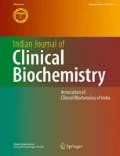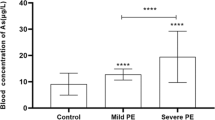Abstract
To correlate blood lead levels (BLLs) and oxidative stress parameters in pregnant anemic women. A total of 175 pregnant women were found suitable and included for this study. Following WHO criteria, 50 each were identified as non-anemic, mild anemic and moderate anemic and 25 were severe anemic. The age of all study subjects ranged from 24–41 years. At admission, BLLs and oxidative stress parameters were estimated as per standard protocols and subjected with ANOVA, Pearson correlation analysis and cluster analysis. Results showed significantly (p < 0.01) high BLLs, zinc protoporphyrin (ZPP), oxidized glutathione (GSSG), lipid peroxide (LPO) levels while low delta aminolevulinic acid dehydratase (δ-ALAD), iron (Fe), selenium (Se), zinc (Zn), haemoglobin (Hb), haematocrit (Hct), mean corpuscular volume (MCV), mean corpuscular haemoglobin (MCH), mean corpuscular haemoglobin concentration (MCHC), red blood cell (RBC) count, reduced glutathione (GSH), superoxide dismutase (SOD), catalase (CAT) and total antioxidant capacity (TAC) in all groups of anemic pregnant women as compared with non anemic pregnant women. In all groups of pregnant women, BLLs showed significant (p < 0.01) and direct association with ZPP, GSSG and LPO while inverse relation with δ-ALAD, Fe, Se, Zn, Hb, Hct, MCV, MCH, MCHC, RBC, GSH, SOD, CAT and TAC. Study concluded that low BLLs perturb oxidant-antioxidant balance and negatively affected hematological parameters which may eventually Pb to Fe deficiency anemia during pregnancy.


Similar content being viewed by others
References
Caroline Ros B, Lillian M. Lead exposure, interactions and toxicity: food for thought. Asia Pacific J Clin Nutr. 2003;12:388–95.
Courtois E, Marques M, Barrientos A. Lead-induced down-regulation of soluble guanylate cyclase in isolated rat aortic segments mediated by reactive oxygen species and cyclo-oxygenase-2. J Am Soc Nephrol. 2003;14:1464–70.
Ahamed M, Verma S, Kumar A, Siddiqui MKJ. Environmental exposure to lead and its correlation with biochemical indices in children. Sci Total Environ. 2005;346:48–55.
Donaldson WE, Knowles SO. Is lead toxicosis a reflection of altered fatty acid composition of membrane? Comp Biochem Physiol C. 1993;104:377–9.
Leggett RW. An age specific kinetic model of lead metabolism in humans. Environ Health Perspect. 1993;101:598–616.
Menke A, Muntner P, Batuman P, Silbergeld EK, Guallar E. Blood lead below 0.48 μg/dl (10 μg/dl) and mortality among US adults. Circulation. 2006;114:1388–94.
Ong CN, Phoon WO, Law HY, Tye CY, Lim HH. Concentrations of lead in maternal blood, cord blood and breast milk. Arch Dis Child. 1985;60:756–9.
Roels H, Hubermont G, Buchet JP, Lauwerys R. Placental transfer of lead, mercury, cadmium, and carbon monoxide in women. III. Factors influencing the accumulation of heavy metals in the placenta and the relationship between metal concentration in the placenta and in maternal and cord blood. Environ Res. 1978;16:236–47.
Foster WG. Reproductive toxicity of chronic lead exposure in the female cynomolgus monkey. Reprod Toxicol. 1992;6:123–31.
Sierra EM, Tiffany-Castiglioni E. Effects of low-level lead exposure on hypothalamic hormones and serum progesterone levels in pregnant guinea pigs. Toxicology. 1992;72:89–97.
Moser R, Oberley TD, Daggett DA, Friedman AL, Johnson JA, Siegel FL. Effects of lead administration on developing rat kidney. I. Glutathione S-transferase isoenzymes. Toxicol Appl Pharmacol. 1995;131:85–93.
Corpas I, Gaspar I, Martinez S, Codesal J, Candelas S, Antonio MT. Testicular alterations in rats due to gestational and early lactational administration of lead. Reprod Toxicol. 1995;9:307–13.
Buchheim K, Noack S, Stoltenburg G, Lilienthal H, Winneke G. Developmental delay of astrocytes in hippocampus of rhesus monkeys reflects the effect of pre and postnatal chronic low level lead exposure. Neurotoxicology. 1994;15:665–9.
Andrews KW, Savitz DA, Hertz-Picciotto I. Prenatal lead exposure in relation to gestational age and birth weight: a review of epidemiologic studies. Am J Ind Med. 1994;26:13–32.
Bellinger D, Leviton A, Allred E, Rabinowitz M. Pre- and postnatal lead exposure and behavior problems in school-aged children. Environ Res. 1994;66:12–30.
Rothenberg SJ, Poblano A, Garza-Morales S. Prenatal and perinatal low level lead exposure alters brainstem auditory evoked responses in infants. Neurotoxicology. 1994;15:695–9.
West WL, Knight EM, Edwards CH, Manning M, Spurlock B, James H, et al. Maternal low level lead and pregnancy outcomes. J Nutr. 1994;124(98):1S–6S.
Bogden JD, Kemp FW, Han S, Murphy M, Fraiman M, Czerniach D. Dietary calcium and lead interact to modify maternal blood pressure, erythropoiesis, and fetal and neonatal growth in rats during pregnancy and lactation. J Nutr. 1995;125:990–1002.
Kristensen P, Eilertsen E, Einarsdottir E, Haugen A, Skaug V, Ovrebo S. Fertility in mice after prenatal exposure to benzo[a]pyrene and inorganic lead. Environ Health Perspect. 1995;103:588–90.
Mahaffey KR. Environmental lead toxicity: nutritional as a component of intervention. Environ Health Perspect. 1990;89:75–8.
Kwong WT, Friello P, Semba RD. Interactions between iron deficiency and lead poisoning: epidemiology and pathogenesis. Sci Total Environ. 2004;330:21–37.
Conrad ME. Newly identified iron-binding protein in human duodenal mucosa. Blood. 1992;79:244–7.
World Health Organization (WHO)/United Nations Children’s Fund/United Nations University. Iron deficiency: indicators for assessment and strategies for prevention. Geneva: WHO, 1998.
International Nutritional Anemia Consultative Group. Measurements of iron status. Washington: INACG; 1985.
Kaneko JJ, editor. Clinical biochemistry of domestic animals. 4th ed. New York: Academic; 1999.
Berlin A, Schaller KH. European standardized method for the determination of aminolevulinic acid dehydratase activity a blood. Zeitseh Klin Chem Klin Biochim. 1974;12:389–90.
Blumberg WE, Eisinger J, Lamola AA, Zuckeman DM. The hematofluorometer. Clin Chem. 1977;23:270–4.
Ellman GL. Tissue sulfhydryl groups. Arch Biochem. 1959;82:70–7.
Ohkawa H, Oshiba N, Yagi K. Assay of lipid peroxides in animal tissue by thiobarbituric acid reaction. Anat Biochem. 1979;95:351–8.
Aebi H. Catalase in vitro. Methods Enzymol. 1984;105:121–6.
Mc Cord JM, Fridovich I. Superoxide dismutase: an enzyme functions for erythrocuprin. J Biol Chem. 1969;244:6049–55.
Lowry OH, Rosenbrough NJ, Farr AL, Randell RJ. Protein measurement with folin–phenol reagent. J Biol Chem. 1951;193:265–75.
Bernin Iris FF, Stain JJ. Ferric reducing ability of plasma [FRAP] as a measure of antioxidant power, The FRAP Assay. Anal Biochem. 1996;239:70–6.
Austrin KH, Bishap DF, Wetmur JG, Kaul BC, Davidow B, Desnick RJ. Aminolevulinic acid dehydratase isozymes and lead toxicity. Ann NY Acad Sci. 1987;514:23–9.
Sakai T, Morita Y. Delta-aminolevulinic acid in plasma or whole blood as a sensitive indicator of lead effects, and its relation to the other heme-related parameters. Int Arch Occup Environ Health. 1996;68:126–32.
Marcus AH, Schwartz J. Dose-response curves for erythrocyte porphyrin vs. blood lead: effects of iron status. Environ Res. 1987;44:221–7.
Onalaja VO, Claudio L. Genetic susceptibility to lead poisoning. Environ Health Perspect. 2000;108:23–8.
Gurer-Orhan H, Sabir HU, Ozgunes H. Correlation between clinical indicator of lead poisoning and oxidative stress parameters in controls and lead exposed workers. Toxicology. 2004;195:147–54.
Bechara EJH. Lead poisoning and oxidative stress. Institute of de Quimica, Universidade de Sao Paulo, Brazil. SFRR’s 12th biennial meeting progamme and abstracts, 5–9 May 2004, Crown Plaza, Panamericano Hotel, Buenos Aires, Argentina, S9–46, vol. 36. Free Radic Biol Med; 2004.
Kasperczyk S, Birkner E, Kasperczyk A, Kasperczyk J. Lipids, lipid peroxidation and 7-ketocholesterol in workers exposed to lead. Hum Exp Toxicol. 2005;24:287–95.
Ding Y, Gonick HC, Vaziri ND. Lead promotes hydroxyl radical generation and lipid peroxidation in cultured aortic endothelial cells. Am J Hypertens. 2000;13:552–5.
Valenzuela A, Lefauconnicer JM, Chaudiere J, Bourre JM. Effects of lead acetate on cerebral glutathione peroxidase and catalase in the suckling rat. Neurotoxicology. 1989;10:63–9.
Ahamed M, Verma S, Kumar A, Siddiqui MKJ. Delta-aminolevulinic acid dehydratase inhibition and oxidative stress in relation to blood lead among urban adolescents. Hum Exp Toxicol. 2006;25:547–53.
Patil AJ, Bhagwat VR, Patil JA, Dongre NN, Ambekar JG, Jailkhani R, Das KK. Effect of lead (Pb) exposure on the activity of superoxide dismutase and catalase in battery manufacturing workers (BMW) of Western Maharashtra (India) with Reference to Heme Biosynthesis. Int J Environ Res Public Health. 2006;3:329–37.
Vargas H, Castillo C, Posadas F, Escalante B. Acute lead exposure induces renal heme oxygenase-1 and decreases urinary Na+ excretion. Hum Exp Toxicol. 2003;22:237–44.
Author information
Authors and Affiliations
Corresponding author
Rights and permissions
About this article
Cite this article
Tiwari, A.K.M., Mahdi, A.A., Zahra, F. et al. Evaluation of Low Blood Lead Levels and Its Association with Oxidative Stress in Pregnant Anemic Women: A Comparative Prospective Study. Ind J Clin Biochem 27, 246–252 (2012). https://doi.org/10.1007/s12291-012-0202-2
Received:
Accepted:
Published:
Issue Date:
DOI: https://doi.org/10.1007/s12291-012-0202-2



